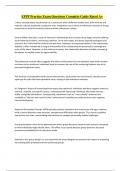EPPP Practice Exam Questions Complete Guide Rated A+
J. Berry conceptualizes acculturation as a continuum where different models exist, with minority and
majority cultures positioned at opposite ends. Integration occurs when an individual maintains a strong
connection to both the minority culture and the mainstream culture.
Lenore Walker describes a cycle of violence in relationships that includes three stages: tension building,
acute battering incidents, and loving contrition. In the third stage, the abuser typically apologizes and
reassures the victim that the violence will not recur, leading to a temporary balance in the relationship.
Stability is often maintained as long as the benefits of the relationship are perceived to outweigh the
costs of the abuse. However, as the violence increases, the relationship becomes unstable, prompting
the abuser to employ charm to regain stability.
The behavioral contrast effect suggests that when reinforcement for one behavior stops while another
continues to be reinforced, individuals tend to increase the rate of the remaining behavior due to its
perceived heightened value.
The doctrine of comparable worth asserts that workers, particularly men and women, should receive
equal pay for jobs that have equivalent value, relying on job evaluation methods.
M. Seligman's theory of learned optimism posits that optimistic individuals attribute negative events to
external, unstable, and specific causes, contrasting with depressed individuals who make internal,
stable, and global attributions. Consequently, statements such as "I was unlucky" (external and
unstable) or "the test was hard this time" (external and unstable) are preferred over more negative
internal attributions.
Antisocial Personality Disorder (APD) typically presents symptoms that may lessen with age; however,
while criminal behaviors may decrease, interpersonal difficulties often persist. This chronic condition
may evolve over time, necessitating interventions to navigate personality-related challenges.
Group polarization refers to the phenomenon where group decisions become more extreme compared
to what individuals might decide alone. This effect occurs partly because group dynamics decrease
personal accountability for the decisions made.
Solomon's four-group design is a true experimental setup designed to ascertain the impact of pretesting
by including both pretested and non-pretested groups.
,MANOVA, or multivariate analysis of variance, is utilized to investigate the effects of one or more
independent variables on multiple dependent variables, which must be measured on an interval or ratio
scale.
Factorial ANOVA examines data derived from factorial designs involving two or more independent
variables, allowing for the evaluation of both individual and interaction effects on a dependent variable
measured on an interval or ratio scale.
One-way ANOVA is applicable when a study involves a single independent variable and multiple
independent groups.
Split-plot (mixed) ANOVA is suitable for research designs that combine at least one independent variable
tested between groups and another tested within subjects.
The experiment-wise error rate refers to the overall probability of a Type I error across all analyses
conducted on a dataset.
Capitation is a reimbursement method commonly used by health maintenance organizations (HMOs),
where providers receive a fixed payment for each enrolled individual, irrespective of the volume of
services utilized.
A time-series quasi-experimental design comprises observing a single group over an extended time. This
design allows researchers to identify trends by gathering data multiple times before and after
introducing a treatment, establishing a baseline for comparison. The numerous data points help to
mitigate alternative explanations for any observed changes, although potential threats to internal
validity include testing effects due to repeated measurements, maturation, and selection bias due to the
absence of a control group.
Transvestic fetishism involves heterosexual males experiencing recurrent and intense sexual arousal
through cross-dressing fantasies, urges, or behaviors.
Exhibitionism is characterized by the act of exposing one's genitalia to an unsuspecting individual.
, Gender Identity Disorder ✔️strong and persistent cross-gender identification with evidence of clinically
significant distress or impairment in social, occupational, or other areas of functioning.
cognitive dissonance ✔️The theory that we act to reduce the discomfort we feel when two of our
thoughts are inconsistent. For example, when our awareness of our attitudes and our actions clash, we
can reduce the resulting dissonance by changing our attitudes.
A person is motivated to reduce the negative, aversive state that results when his or her cognitions
conflict with each other. From the perspective of this theory, the poor client paying a very high fee
would experience a state of dissonance. Therefore, this client, more than those in the other responses,
would be motivated to believe that he or she is benefitting from therapy.
Sleep patterns of persons with/at-risk of depression ✔️Research has found that depression is most
associated with a more rapid onset of REM sleep, decreased percentage of slow wave sleep, and
increased percentage of REM sleep. The research also suggests that individuals with no prior history of
depression but who have rapid REM onset have an increased risk of developing depression (e.g., D.
Giles, D. Kupfer, A. Rush, & H. Roffwarg, Controlled comparison of electrophysiological sleep in families
of probands with unipolar depression. American Journal of Psychiatry, 1998, 155(2), 192-199).
blocking ✔️Blocking occurs when a CS is presented simultaneously with a second stimulus just before
the US. Although it would seem that the second stimulus should acquire the properties of a CS from this
procedure, that's not what happens. Instead, the second stimulus does not produce a conditioned
response.
Alderian ✔️For Adlerians, a desire to belong is a primary motivator of behavior, but this desire may be
channeled into the mistaken goals of power, attention, inadequacy, or revenge., Feelings of inferiority
contribute to problems in children and adults
Teological approach-behavior is shaped by future goals (NOT the past)
Innate social interest motivates people, ways to fulfill social responsibility
Key Concepts:
Inferiority feelings
Striving for superiority
Style of Life




